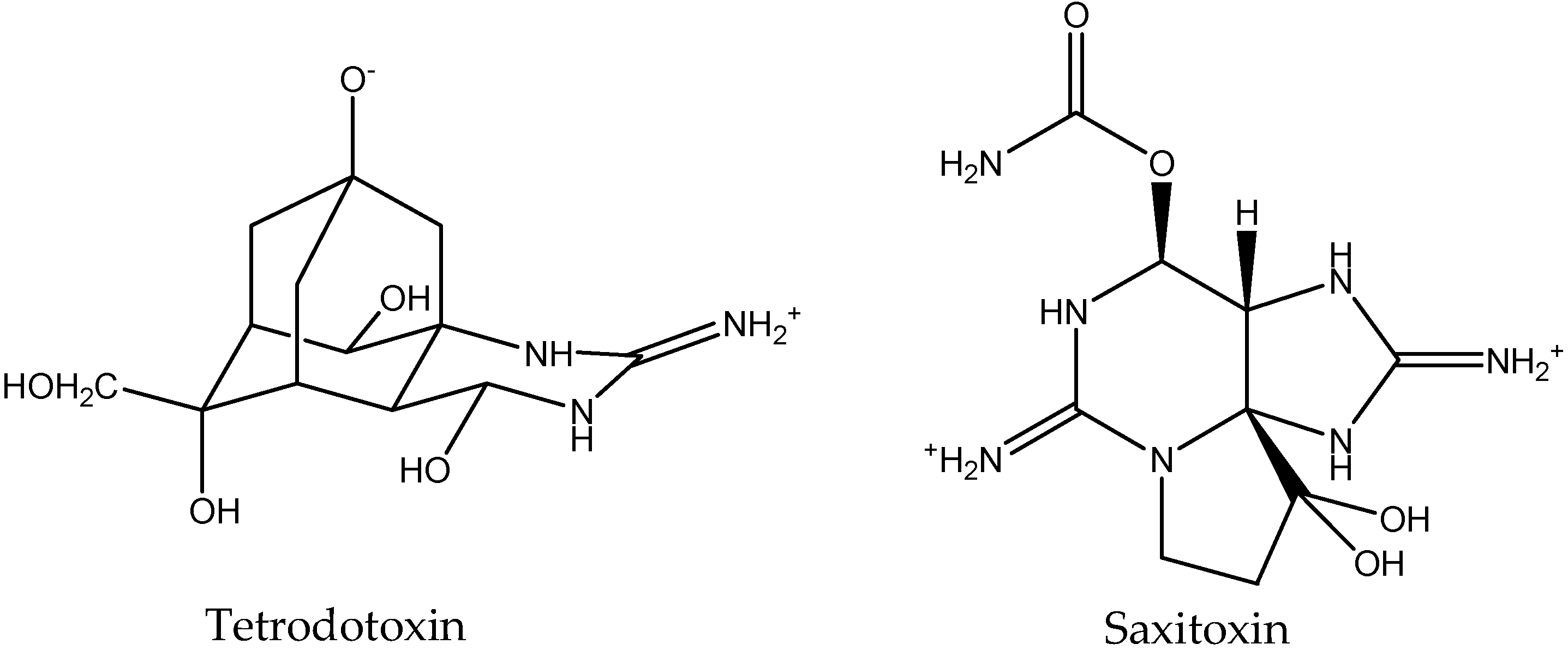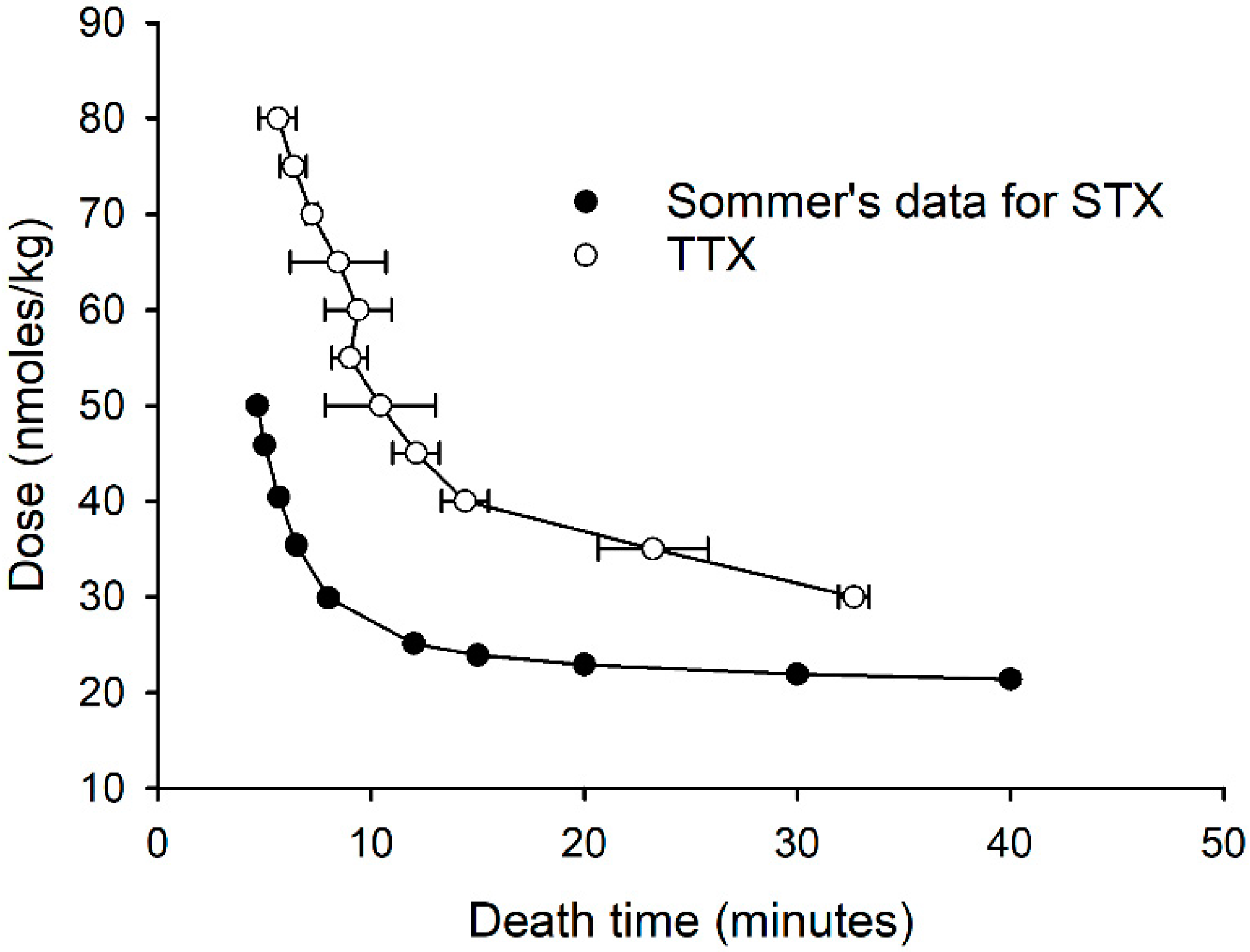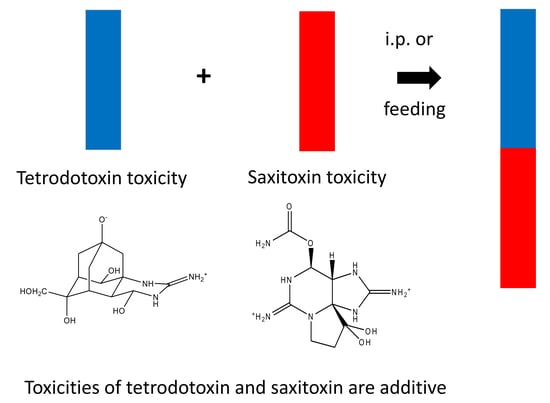The Acute Toxicity of Tetrodotoxin and Tetrodotoxin–Saxitoxin Mixtures to Mice by Various Routes of Administration
Abstract
1. Introduction
2. Results
2.1. Purity of TTX and STX
2.2. Determination of the Specific Activities of STX and TTX by the PSP MBA
2.3. Determination of the Correlation between Dose Rate and Death Time for TTX
2.4. Determination of Median Lethal Doses by i.p. Injection
2.5. Determination of Median Lethal Doses and NOAELs by Oral Administration
3. Discussion
4. Materials and Methods
4.1. Purity and Quantity Assessment of TTX and STX
4.2. Animals
4.3. Determination of the Specific Activities of STX and TTX by the PSP MBA
4.4. Determination of the Correlation between Dose Rate and Death Time for TTX
4.5. Determination of Median Lethal Doses
4.6. Determination of NOAEL
Supplementary Materials
Author Contributions
Funding
Acknowledgments
Conflicts of Interest
References
- Goto, T.; Kishi, Y.; Takahashi, S.; Hirata, Y. Tetrodotoxin. Tetrahedron 1965, 21, 2059–2088. [Google Scholar] [CrossRef]
- Noguchi, T.; Arakawa, O. Tetrodotoxin—Distribution and Accumulation in Aquatic Organisms, and Cases of Human Intoxication. Mar. Drugs 2008, 6, 220–242. [Google Scholar] [CrossRef] [PubMed]
- Hwang, D.F.; Noguchi, T. Tetrodotoxin Poisoning. In Advances in Food and Nutrition Research; Academic Press: Cambridge, MA, USA, 2007; Volume 52, pp. 141–236. [Google Scholar]
- Hwang, P.-A.; Tsai, Y.-H.; Lin, S.-J.; Hwang, D.-F. The Gastropods Possessing TTX and/or PSP. Food Rev. Int. 2007, 23, 321–340. [Google Scholar] [CrossRef]
- Hwang, D.F.; Tsai, Y.H. Toxins in toxic Taiwanese crabs. Food Rev. Int. 1999, 15, 145–162. [Google Scholar] [CrossRef]
- Miyazawa, K.; Jeon, J.K.; Noguchi, T.; Ito, K.; Hashimoto, K. Distribution of tetrodotoxin in the tissues of the flatworm Planocera multitentaculata (Platyhelminthes). Toxicon 1987, 25, 975–980. [Google Scholar] [CrossRef]
- Ali, A.E.; Arakawa, O.; Noguchi, T.; Miyazawa, K.; Shida, Y.; Hashimoto, K. Tetrodotoxin and related substances in a ribbon worm Cephalothrix linearis (Nemertean). Toxicon 1990, 28, 1083–1093. [Google Scholar] [CrossRef]
- Thuesen, E.V.; Kogure, K.; Hashimoto, K.; Nemoto, T. Poison arrowworms: A tetrodotoxin venom in the marine phylum Chaetognatha. J. Exp. Mar. Biol. Ecol. 1988, 116, 249–256. [Google Scholar] [CrossRef]
- Miyazawa, K.; Noguchi, T. Distribution and origin of Tetrodotoxin. J. Toxicol. Toxin Rev. 2001, 20, 11–33. [Google Scholar] [CrossRef]
- Noguchi, T.; Narita, H.; Maruyama, J.; Hashimoto, K. Tetrodotoxin in the Starfish Astropecten polyacanthus, in Association with Toxification of a Trumpet Shell, “Boshubora” Charonia sauliae. Nippon Suisan Gakkaishi 1982, 48, 1173–1177. [Google Scholar] [CrossRef]
- McNabb, P.; Selwood, A.I.; Munday, R.; Wood, S.A.; Taylor, D.I.; MacKenzie, L.A.; van Ginkel, R.; Rhodes, L.L.; Cornelisen, C.; Heasman, K.; et al. Detection of tetrodotoxin from the grey side-gilled sea slug—Pleurobranchaea maculata, and associated dog neurotoxicosis on beaches adjacent to the Hauraki Gulf, Auckland, New Zealand. Toxicon 2010, 56, 466–473. [Google Scholar] [CrossRef] [PubMed]
- Freeman, S.E.; Turner, R.J. Maculotoxin, a potent toxin secreted by Octopus maculosus Hoyle. Toxicol. Appl. Pharmacol. 1970, 16, 681–690. [Google Scholar] [CrossRef]
- Brown, M.S.; Mosher, H.S. Tarichatoxin: Isolation and Purification. Science 1963, 140, 295–296. [Google Scholar] [CrossRef] [PubMed]
- Kim, Y.H.; Brown, G.B.; Mosher, H.S.; Fuhrman, F.A. Tetrodotoxin: Occurrence in Atelopid Frogs of Costa Rica. Science 1975, 189, 151–152. [Google Scholar] [CrossRef] [PubMed]
- Stokes, A.N.; Ducey, P.K.; Neuman-Lee, L.; Hanifin, C.T.; French, S.S.; Pfrender, M.E.; Brodie, E.D., III; Brodie, E.D., Jr. Confirmation and Distribution of Tetrodotoxin for the First Time in Terrestrial Invertebrates: Two Terrestrial Flatworm Species (Bipalium adventitium and Bipalium kewense). PLoS ONE 2014, 9, e100718. [Google Scholar] [CrossRef] [PubMed]
- Rodríguez, P.; Alfonso, A.; Otero, P.; Katikou, P.; Georgantelis, D.; Botana, L.M. Liquid chromatography–mass spectrometry method to detect Tetrodotoxin and its analogues in the puffer fish Lagocephalus sceleratus (Gmelin, 1789) from European waters. Food Chem. 2012, 132, 1103–1111. [Google Scholar] [CrossRef]
- Kodama, M.; Sato, S.; Ogata, T. Alexandrium tamarense as a source of tetrodotoxin in the scallop Patinopectin yessoensis. In Toxic Phytoplankton Blooms in the Sea; Smayda, T.J., Shimizu, Y., Eds.; Elsevier: New York, NY, USA, 1993; pp. 401–406. [Google Scholar]
- McNabb, P.S.; Taylor, D.I.; Ogilvie, S.C.; Wilkinson, L.; Anderson, A.; Hamon, D.; Wood, S.A.; Peake, B.M. First Detection of Tetrodotoxin in the Bivalve Paphies australis by Liquid Chromatography Coupled to Triple Quadrupole Mass Spectrometry with and without Precolumn Reaction. J. AOAC Int. 2014, 97, 325–333. [Google Scholar] [CrossRef] [PubMed]
- Turner, A.D.; Powell, A.; Schofield, A.; Lees, D.N.; Baker-Austin, C. Detection of the pufferfish toxin tetrodotoxin in European bivalves, England, 2013 to 2014. Eurosurveillance 2015, 20, 21009. [Google Scholar] [CrossRef] [PubMed]
- Vlamis, A.; Katikou, P.; Rodriguez, I.; Rey, V.; Alfonso, A.; Papazachariou, A.; Zacharaki, T.; Botana, A.; Botana, L. First Detection of Tetrodotoxin in Greek Shellfish by UPLC-MS/MS Potentially Linked to the Presence of the Dinoflagellate Prorocentrum minimum. Toxins 2015, 7, 1779–1807. [Google Scholar] [CrossRef] [PubMed]
- Zhang, X.; Yan, Z.; Wang, Y.; Jiang, T.; Wang, J.; Sun, X.; Guo, Y. Immunoaffinity Chromatography Purification and Ultrahigh Performance Liquid Chromatography Tandem Mass Spectrometry Determination of Tetrodotoxin in Marine Organisms. J. Agric. Food Chem. 2015, 63, 3129–3134. [Google Scholar] [CrossRef] [PubMed]
- EFSA CONTAM Panel (EFSA Panel on Contaminants in the Food Chain); Knutsen, H.K.; Alexander, J.; Barregård, L.; Bignami, M.; Brüschweiler, B.; Ceccatelli, S.; Cottrill, B.; Dinovi, M.; Edler, L.; et al. Scientific opinion on the risks for public health related to the presence of tetrodotoxin (TTX) and TTX analogues in marine bivalves and gastropods. EFSA J. 2017, 15, 4752. [Google Scholar]
- Lago, J.; Rodríguez, P.L.; Blanco, L.; Vieites, M.J.; Cabado, G.A. Tetrodotoxin, an Extremely Potent Marine Neurotoxin: Distribution, Toxicity, Origin and Therapeutical Uses. Mar. Drugs 2015, 13, 6384–6406. [Google Scholar] [CrossRef] [PubMed]
- Moczydlowski, E.G. The molecular mystique of tetrodotoxin. Toxicon 2013, 63, 165–183. [Google Scholar] [CrossRef] [PubMed]
- Bane, V.; Lehane, M.; Dikshit, M.; O’Riordan, A.; Furey, A. Tetrodotoxin: Chemistry, Toxicity, Source, Distribution and Detection. Toxins 2014, 6, 693–755. [Google Scholar] [CrossRef] [PubMed]
- Narahashi, T. Mechanism of Tetrodotoxin and Saxitoxin Action. In Handbook of Natural Toxins; Tu, A.T., Ed.; Marcel Dekker, Inc.: New York, NY, USA; Basel, Switzerland, 1988; Volume 3. [Google Scholar]
- Walker, J.R.; Novick, P.A.; Parsons, W.H.; McGregor, M.; Zablocki, J.; Pande, V.S.; Du Bois, J. Marked difference in saxitoxin and tetrodotoxin affinity for the human nociceptive voltage-gated sodium channel (Nav1.7). Proc. Natl. Acad. Sci. USA 2012, 109, 18102–18107. [Google Scholar] [CrossRef] [PubMed]
- Munday, R.; Thomas, K.; Gibbs, R.; Murphy, C.; Quilliam, M.A. Acute toxicities of saxitoxin, neosaxitoxin, decarbamoyl saxitoxin and gonyautoxins 1&4 and 2&3 to mice by various routes of administration. Toxicon 2013, 76, 77–83. [Google Scholar] [PubMed]
- Selwood, A.I.; Waugh, C.; Harwood, D.T.; Rhodes, L.L.; Reeve, J.; Sim, J.; Munday, R. Acute Toxicities of the Saxitoxin Congeners Gonyautoxin 5, Gonyautoxin 6, Decarbamoyl Gonyautoxin 2&3, Decarbamoyl Neosaxitoxin, C-1&2 and C-3&4 to Mice by Various Routes of Administration. Toxins 2017, 9, 73. [Google Scholar]
- Standard for Live and Raw Bivalve Molluscs Codex Stan 292-2008. Available online: http://www.fao.org/fao-who-codexalimentarius/sh-proxy/es/?lnk=1&url=https%253A%252F%252Fworkspace.fao.org%252Fsites%252Fcodex%252FStandards%252FCODEX%2BSTAN%2B292-2008%252FCXS_292e_2015.pdf (accessed on 23 October 2018).
- Botana, L.M.; Hess, P.; Munday, R.; Nathalie, A.; DeGrasse, S.L.; Feeley, M.; Suzuki, T.; van den Berg, M.; Fattori, V.; Garrido Gamarro, E.; et al. Derivation of toxicity equivalency factors for marine biotoxins associated with Bivalve Molluscs. Trends Food Sci. Technol. 2017, 59, 15–24. [Google Scholar] [CrossRef]
- FAO/WHO. Technical Paper on Toxicity Equivalency Factors for Marine Biotoxins Associated with Bivalve Molluscs; FAO: Rome, Italy, 2016. [Google Scholar]
- Munday, R.; Reeve, J. Risk Assessment of Shellfish Toxins. Toxins 2013, 5, 2109–2137. [Google Scholar] [CrossRef] [PubMed]
- Xu, Q.; Kai, H.; Gao, L.; Zhang, H. Toxicity of tetrodotoxin towards mice and rabbits. J. Hyg. Res. 2003, 32, 371–374. [Google Scholar]
- Kao, C.Y.; Fuhrman, F.A. Pharmacological studies on Tarichatoxin, a potent neurotoxin. J. Pharmacol. Exp. Ther. 1963, 140, 31. [Google Scholar] [PubMed]
- Abal, P.; Louzao, M.; Antelo, A.; Alvarez, M.; Cagide, E.; Vilariño, N.; Vieytes, M.; Botana, L. Acute Oral Toxicity of Tetrodotoxin in Mice: Determination of Lethal Dose 50 (LD50) and No Observed Adverse Effect Level (NOAEL). Toxins 2017, 9, 75. [Google Scholar] [CrossRef] [PubMed]
- Hungerford, J.M. General Referee Reports, Committee on Natural Toxins and Food Allergens: Marine and Freshwater Toxins. J. AOAC Int. 2006, 89, 248–269. [Google Scholar] [PubMed]
- AOAC Official Method 959.08. Paralytic shellfish poisoning. Biological method. In Official Methods of Analysis of AOAC International, 18th ed.; Horwitz, W., Latimer, G.W., Eds.; AOAC International: Gaithersburg, MD, USA, 2005; pp. 79–82. [Google Scholar]
- Regulation (EC) No 853/2004 of the European Parliament and of the Council of 29 April 2004; Laying down Specific Hygiene Rules for Food of Animal Origin. Available online: www.fsai.ie/uploadedFiles/Reg853_2004(1).pdf (accessed on 23 October 2018).
- EFSA. Scientific Opinion of the Panel on Contaminants in the Food Chain on a request from the European Commission on Marine Biotoxins in Shellfish—Saxitoxin group. EFSA J. 2009, 1019, 1–76. [Google Scholar]
- OECD Guidelines for the Testing of Chemicals; Acute Oral Toxicity—Up-and-Down Procedure (UDP). Available online: http://www.oecd.org/env/test-no-425-acute-oral-toxicity-up-and-down-procedure-9789264071049-en.htm (accessed on 23 October 2018).
- Munday, R. Toxicology of Seafood Toxins: A Critical Review. In Seafood and Freshwater Toxins: Pharmacology, Physiology, and Detection, 3rd ed.; Botana, L.M., Ed.; CRC Press: Boca Raton, FL, USA, 2014; pp. 197–290. [Google Scholar]
- Boundy, M.J.; Selwood, A.I.; Harwood, D.T.; McNabb, P.S.; Turner, A.D. Development of a sensitive and selective liquid chromatography–mass spectrometry method for high throughput analysis of paralytic shellfish toxins using graphitised carbon solid phase extraction. J. Chromatogr. A 2015, 1387, 1–12. [Google Scholar] [CrossRef] [PubMed]
- Turner, A.D.; McNabb, P.S.; Harwood, D.T.; Selwood, A.I.; Boundy, M.J. Single-Laboratory Validation of a Multitoxin Ultra-Performance LC-Hydrophilic Interaction LC-MS/MS Method for Quantitation of Paralytic Shellfish Toxins in Bivalve Shellfish. J. AOAC Int. 2015, 98, 609–621. [Google Scholar] [CrossRef] [PubMed]
- USEPA User Documentation for the AOT425StatPgm Program. 2002. Available online: http://www.oecd.org/dataoecd/19/57/1839830.pdf (accessed on 24 May 2001).


| Compound Name | % Contribution |
|---|---|
| TTX | 99.54% |
| 4epi-TTX | 0.19% 1 |
| 4,9-anhydro-TTX | 0.27% |
| Compound Name | % Contribution |
|---|---|
| STX | 99.79% |
| neoSTX | 0.05% |
| dcSTX | 0.16% |
| Compound | Predicted LD50 | LD50 (nmol/kg) 1 |
|---|---|---|
| STX | 24.0 (22.1–24.8) | |
| TTX | 31.2 (27.6–35.0) | |
| STX/TTX (1:2) | 28.4 | 27.8 (23.3–32.0) |
| STX/TTX (1:1) | 27.1 | 24.0 (22.1–24.8) |
| STX/TTX (2:1) | 26.0 | 24.8 (21.6–29.6) |
| Compound | LD50 by Gavage (nmol/kg) 1 | Predicted LD50 by Feeding | LD50 by Feeding (nmol/kg) 1 | NOAEL by Feeding (nmol/kg) 1 |
|---|---|---|---|---|
| STX | 1237 (1056–1630) | 2850 (2468–3390) | 1270 (1189–1470) | |
| TTX | 1890 (1669–2120) | 2850 (2475–3410) | 1294 (888–1480) | |
| STX/TTX (1:2) | ND | 2850 | 3532 (3016–7830) | ND |
| STX/TTX (1:1) | ND | 2850 | 2850 (2382–3280) | ND |
| STX/TTX (2:1) | ND | 2850 | 2850 (2475–3410) | ND |
| Compound | Relative LD50 by i.p. | Relative LD50 by Gavage | Relative LD50 by Feeding |
|---|---|---|---|
| Saxitoxin | 1.0 | 1.0 | 1.0 |
| Tetrodotoxin | 0.77 | 0.65 | 1.0 |
| Analogue(s) | Precursor Mass (m/z) | Product Mass (m/z) | Collision Energy |
|---|---|---|---|
| 11-oxo-TTX (hydrated aldehyde) | 336.1 | 318.1 | 25 |
| 336.1 | 162.1 | 35 | |
| (4/6-epi)-TTX | 320.1 | 302.1 | 26 |
| 320.1 | 162.1 | 38 | |
| 11-oxo-TTX (aldehyde) | 318.1 | 300.1 | 20 |
| 318.1 | 162.0 | 30 | |
| 11-norTTX-6,6-diol | 306.1 | 288.1 | 25 |
| 306.1 | 60.0 | 35 | |
| (5/11)-deoxy-TTX | 304.1 | 286.1 | 35 |
| 304.1 | 240.1 | 35 | |
| 304.1 | 176.1 | 35 | |
| 4,9-anhydro-TTX | 302.1 | 256.1 | 35 |
| 302.1 | 162.1 | 35 | |
| (4-epi)-11-nor TTX-6S-ol (4-epi)-11-nor TTX-6R-ol | 290.1 | 272.1 | 26 |
| 290.1 | 226.0 | 30 | |
| 290.1 | 60.1 | 35 | |
| 5,11-dideoxyTTX 6,11 dideoxyTTX 4,9-anhydro-11-norTTX-6,6-diol | 288.1 | 270.1 | 25 |
| 288.1 | 162.1 | 35 | |
| 288.1 | 60.1 | 35 | |
| 4,9-anhydro-5-deoxy-TTX iso-anhydro-deoxy-TTX 4,9-anhydro-11-deoxy-TTX | 286.1 | 135.1 | 30 |
| 286.1 | 60.1 | 25 | |
| (4-epi)-5,6,11-trideoxyTTX 4,9-anhydro-11-norTTX-6(S/R)-ol | 272.1 | 254.1 | 20 |
| 272.1 | 95.0 | 35 | |
| 272.1 | 60.0 | 35 | |
| 4,9-anhydro-5,11-dideoxyTTX 4,9-anhydro-6,11-dideoxyTTX Iso-anhydro-dideoxy-TTX | 270.1 | 176.1 | 25 |
| 270.1 | 166.1 | 25 | |
| 270.1 | 60.1 | 25 | |
| 4,9-anhydro-5,6,11-trideoxy-TTX | 254.1 | 208.1 | 26 |
| 254.1 | 60.1 | 35 |
| Analogue(s) | Ionisation Mode | Precursor (m/z) | Product (m/z) | Q1 Prebias (V) | Collision Energy | Q3 Prebias (V) |
|---|---|---|---|---|---|---|
| C3,4 | ESI− | 490.1 | 122.0 | 11 | 33 | 12 |
| C1,2 | ESI− | 474.1 | 122.0 | 11 | 29 | 21 |
| GTX1,4 | ESI− | 410.1 | 367.1 | 12 | 15 | 27 |
| GTX2,3 | ESI− | 394.1 | 351.1 | 12 | 16 | 27 |
| GTX6 | ESI− | 394.1 | 122.0 | 19 | 22 | 13 |
| GTX5 | ESI− | 378.1 | 122.0 | 14 | 23 | 24 |
| dcGTX1,4 | ESI− | 367.1 | 349.1 | 13 | 18 | 15 |
| dcGTX2,3 | ESI− | 351.1 | 333.1 | 13 | 18 | 15 |
| NEO | ESI+ | 316.1 | 126.0 | −22 | −24 | −24 |
| STX | ESI+ | 300.1 | 204.1 | −15 | −24 | −14 |
| dcNEO | ESI+ | 273.1 | 225.1 | −13 | −22 | −15 |
| dcSTX | ESI+ | 257.1 | 126.0 | −13 | −21 | −23 |
© 2018 by the authors. Licensee MDPI, Basel, Switzerland. This article is an open access article distributed under the terms and conditions of the Creative Commons Attribution (CC BY) license (http://creativecommons.org/licenses/by/4.0/).
Share and Cite
Finch, S.C.; Boundy, M.J.; Harwood, D.T. The Acute Toxicity of Tetrodotoxin and Tetrodotoxin–Saxitoxin Mixtures to Mice by Various Routes of Administration. Toxins 2018, 10, 423. https://doi.org/10.3390/toxins10110423
Finch SC, Boundy MJ, Harwood DT. The Acute Toxicity of Tetrodotoxin and Tetrodotoxin–Saxitoxin Mixtures to Mice by Various Routes of Administration. Toxins. 2018; 10(11):423. https://doi.org/10.3390/toxins10110423
Chicago/Turabian StyleFinch, Sarah C., Michael J. Boundy, and D. Tim Harwood. 2018. "The Acute Toxicity of Tetrodotoxin and Tetrodotoxin–Saxitoxin Mixtures to Mice by Various Routes of Administration" Toxins 10, no. 11: 423. https://doi.org/10.3390/toxins10110423
APA StyleFinch, S. C., Boundy, M. J., & Harwood, D. T. (2018). The Acute Toxicity of Tetrodotoxin and Tetrodotoxin–Saxitoxin Mixtures to Mice by Various Routes of Administration. Toxins, 10(11), 423. https://doi.org/10.3390/toxins10110423







